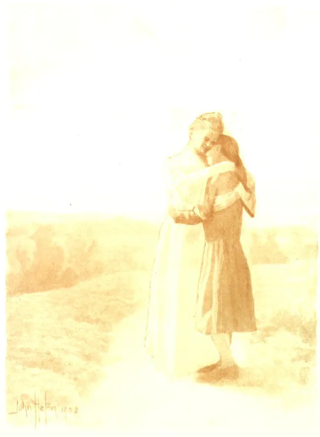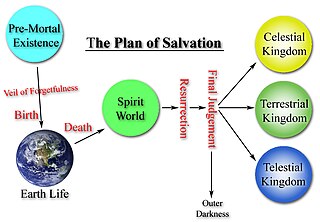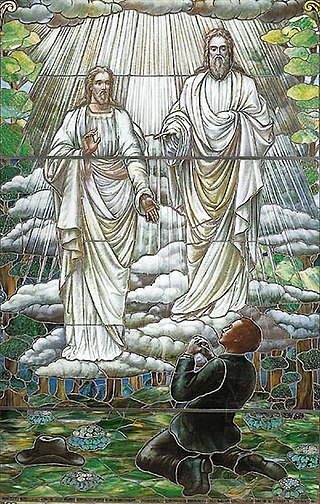
The Adam–God doctrine was a theological idea taught in mid-19th century Mormonism by Brigham Young, a president of the Church of Jesus Christ of Latter-day Saints. Although the doctrine is rejected by the LDS Church today, it is still an accepted part of the modern theology of some Mormon fundamentalists.

The Book of Abraham is a religious text of the Latter Day Saint movement, first published in 1842 by Joseph Smith. Smith said the book was a translation from several Egyptian scrolls discovered in the early 19th century during an archeological expedition by Antonio Lebolo, and purchased by members of the Church of Jesus Christ of Latter-day Saints from a traveling mummy exhibition on July 3, 1835. According to Smith, the book was "a translation of some ancient records... purporting to be the writings of Abraham, while he was in Egypt, called the Book of Abraham, written by his own hand, upon papyrus". The Book of Abraham is about Abraham's early life, his travels to Canaan and Egypt, and his vision of the cosmos and its creation.

In the Latter Day Saint movement, Heavenly Mother, also known as Mother in Heaven, is the mother of human spirits and the wife of God the Father. Collectively Heavenly Mother and Father are called Heavenly Parents. Those who accept the Mother in Heaven doctrine trace its origins to Joseph Smith, founder of the Latter Day Saint movement. The doctrine became more widely known after Smith's death in 1844.

In orthodox Mormonism, the term God generally refers to the biblical God the Father, whom Latter Day Saints also refer to as Elohim or Heavenly Father, while the term Godhead refers to a council of three distinct divine persons consisting of God the Father, Jesus Christ, and the Holy Ghost. However, in Latter Day Saint theology the term God may also refer to, in some contexts, the Godhead as a whole or to each member individually.
The House of Joseph is a designation which members of the Church of Jesus Christ of Latter-day Saints apply to the ancient "birthright" tribe of the house of Israel (Jacob) as it is described in the Old Testament, made up of the tribes of Ephraim and Manasseh. The tribes' namesakes — the two sons of Joseph of Egypt — are first mentioned in Genesis 41:50-52.

In the theology and cosmology of Mormonism, in heaven there are three degrees of glory which are the ultimate, eternal dwelling places for nearly all who have lived on earth after they are resurrected from the spirit world.
The Church of Jesus Christ of Latter-day Saints teaches that Adam and Eve were the first man and the first woman to live on the earth and that their fall was an essential step in the plan of salvation. Adam in particular is a central figure in Mormon cosmology.
Hymns are an important part of the history and worship of the Church of Jesus Christ of Latter-day Saints.
The God Makers is a book and film highlighting the inner workings and perceived negative aspects of the Church of Jesus Christ of Latter-day Saints. Ed Decker and Dave Hunt co-authored the book and film.
Search for the Truth is an anti-Mormon video produced by Tri-Grace Ministries. The video begins with the claim that Jesus Christ and Joseph Smith were "two of the world's most prominent and influential men." It then presents what it claims to be the teachings of Joseph Smith and contrasts them to what it claims to be the teachings of Jesus Christ. A question is raised regarding whether the movements which the video classifies as "Christianity" and "Mormonism" are compatible, despite the claim by both that "Jesus is the Christ." The video takes portions of the Book of Mormon and compares it to the Bible. The video implies that people must follow Jesus or Joseph Smith but cannot follow both.

Mormon cosmology is the description of the history, evolution, and destiny of the physical and metaphysical universe according to Mormonism, which includes the doctrines taught by leaders and theologians of the Church of Jesus Christ of Latter-day Saints, Mormon fundamentalism, and other denominations within the Latter Day Saint movement. Mormon cosmology draws from Biblical cosmology, but has many unique elements provided by movement founder Joseph Smith. These views are not generally shared by adherents of other Latter Day Saint movement denominations who do not self-identify as "Mormons", such as the Community of Christ.
Orson Pratt Huish was a Latter Day Saint hymnwriter. He wrote the words and music to "Come Unto Jesus", as well as a few other hymns found in the 1985 English edition of the hymnal of the Church of Jesus Christ of Latter-day Saints. His hymns have been widely sung by many choirs in many locations.

Oliblish is the name given to a star or planet described in the Book of Abraham, a text considered sacred to many denominations of the Latter Day Saint movement, including the Church of Jesus Christ of Latter-day Saints. Several Latter Day Saint denominations hold the Book of Abraham to have been translated from an Egyptian papyrus scroll by Joseph Smith, the founder of the movement. According to this work, the term Oliblish was given as the meaning of the main symbols in one of the images of Smith's hypocephalus. Smith stated that the image is meant to represent a heavenly body located nearest to the central Kolob, the planet or star closest to the throne of God.

The Church of Jesus Christ of Latter-day Saints focuses its doctrine and teaching on Jesus Christ; that he was the Son of God, born of Mary, lived a perfect life, performed miracles, bled from every pore in the Garden of Gethsemane, died on the cross, rose on the third day, appeared again to his disciples, and now resides, authoritatively, on the right hand side of God. In brief, some beliefs are in common with Catholics, Orthodox and Protestant traditions. However, teachings of the LDS Church differ significantly in other ways and encompass a broad set of doctrines, so that the above-mentioned denominations usually place the LDS Church outside the bounds of orthodox Christian teaching as summarized in the Nicene Creed.

The Joseph Smith Hypocephalus was a papyrus fragment, part of a larger collection of papyri known as the Joseph Smith Papyri. The papyri are Egyptian funerary papyrus fragments from ancient Thebes dated between 300 and 100 BC which, along with four mummies, were once owned by Joseph Smith, the founder of the Latter Day Saint movement. The name of the owner Sheshonq is written in the hieroglyphic text on the hypocephalus. Smith purchased the mummies and papyrus documents from a traveling exhibitor in Kirtland, Ohio in 1835. Smith said that the hypocephalus contained records of the ancient patriarch Abraham. In 1842, Smith published the first part of the Book of Abraham, which he said was an inspired translation from the papyri. The consensus among both Mormon and non-Mormon scholars is that the characters on the surviving papyrus fragments do not match Smith's translation.
Islam and Mormonism have been compared to one another since the earliest origins of the latter in the nineteenth century, sometimes by detractors of one or both religions, but also at least once by Joseph Smith, founder of the Latter Day Saint movement, himself. Smith was also frequently referred to as "the Modern Muhammad" by several publications of the era, notably in the New York Herald, shortly after his assassination in June 1844. This epithet repeated a comparison that had been made from Smith's earliest career, one that was not intended at the time to be complimentary.
In the Church of Jesus Christ of Latter-day Saints, marriage between a man and a woman is considered to be "ordained of God". Marriage is thought to consist of a covenant between the man, the woman, and God. The church teaches that in addition to civil marriage, which ends at death, a man and woman can enter into a celestial marriage, performed in a temple by priesthood authority, whereby the marriage and parent–child relationships resulting from the marriage will last forever in the afterlife.









